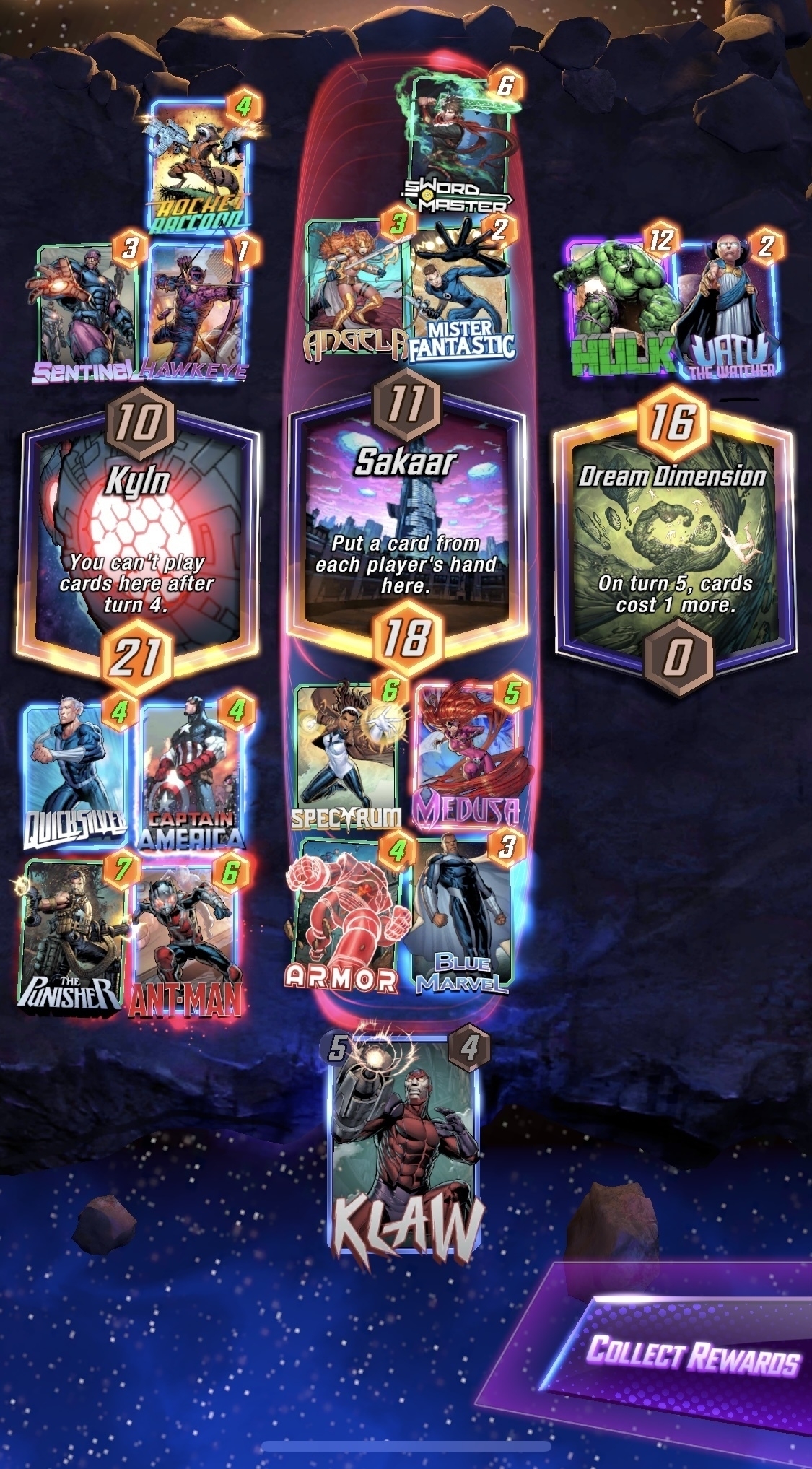date: 2022-10-27
I’ve set a one-hour screen time limit for Marvel Snap; I’m worried that without oversight, I’ll overindulge on this little mobile card game.
While I’ve enjoyed my fair share of CCGs (Hearthstone, Magic: The Gathering) I invariably quit due to expense (buying cards), time (matches can last fractions of an hour! Every season I have to study new tactics!), and accessibility (finding a table; viewing my phone in landscape mode).
I’m not anti-CCG. I’m just busy. I can’t devote 15 minutes of attention to a match, or hours reading on the latest strategies and tier lists.
After reading this (mildly inaccurate) Kotaku Article I gave it a shot.
And the appeal is obvious. Matches are very fast. Can easily sneak in a round on the toilet.1 Small decks do make deck building, experimentation, and strategies easier. A reduced card catalog makes the focus less on collecting cards, and more on making the most of the ones you have. Often the matches lend themselves to thrilling photo finishes, rather than lopsided blowouts.
These factors seem like they would combine to make the game shallow and uncompelling. Snap addresses this in two ways:
- A small, random gameboard. Like Settlers of Catan, territory on the board is gradually revealed every turn, adding an enticing frisson of discovery. Players must stay on their toes, ready to exploit synergies or compensate for counters.
- Your opponent.
But, wait. Other CCGs have opponents as well. This is true, however it can often feel like playing a deck or a meta; in Snap you’re playing against a person.
There’s a poker-like level of psychological warfare taking place in Snap. Reasoning about what territory your opponent will take, what sacrifices they’ll make, and how you can make and avoid traps is all part of the game.
This psychological battle isn’t merely indirect. Unlike some ranked games where your level is tied to hidden ELOs, Snap has poker chips. Errr…cosmic cubes. Your number of cubes directly corresponds to your (seasonal?) rank. Accrue cubes and your rank rises; lose them and your rank declines.
Snap has a mechanic for “betting” cubes, and doubling down. It’s not money at stake, it’s something more valuable—rank! By wagering cubes during matches, players have a level of direct psychological interaction. There are some limited pre-cooked messages and emojis that can be used as reactions, but nothing speaks louder than putting your cubes where your mouth is.
And there are further poker-like attributes. The game is won by controlling two or more territories. Card strength determines control. Eventually the game comes down to quickly assessing probabilities as to what cards, placed where, give what odds of winning. What do you sacrifice? How do you respond to an opponent’s show of strength?
Often I feel like the game is an exercise in overcoming the sunk-cost fallacy: yes, I have invested massively in the left hex, but I’m not going to win it. Cut my losses and move on.
This can be illustrated with a brief case study. I’ll lay out the situation: I have one of three territories locked down. On the other territories I’m down by two and up by one.
In that last round we both have to choose where to throw our resources. Do I attempt to win the territory I’m losing by two, secure the one I hold by one, or invest a little in each?
I make the wrong choice. I choose to secure my held territory, rather than making a bid for the unheld. Because unbeknownst to me my opponent can put a massive drop down and easily take my held territory.
…but they don’t. Failing to read the situation, they double-down on their single held territory. I win by the incompetence of my opponent.

Some would call this “luck”; maybe it is. But the same accusation is leveled at poker. When I’m playing a strategy, reacting to the board, reading my opponent, and gauging the odds it doesn’t seem ruled by luck. But an element of it is surely there. Just enough to keep me playing.
Which brings me back to the screen time limit. I have found that I need a nanny to prevent me from spending all my time Snapping. 2
-
Playing in portrait mode helps with this as well. ↩︎
-
A note on monetization:
You cannot buy cards in Snap, only cosmetics. But you unlock new cards by increasing your collection level which is increased by…unlocking cosmetics.
You can unlock them in-game as well. Missions and every match give you currencies for unlocking cosmetics, which unlock your collection. But it is nonetheless true you can drop $100 to unlock a massive card collection at the outset.
It doesn’t feel pay-to-win, though. I’m still climbing the ladder with a starter deck, as the game is more about playing your opponent and deck conceit than having ultra-powerful diamond cards that are unbeatable.
There’s also a $10 season pass that doubles rewards for season progress. Again, rewards are just cosmetics. But the game is appealing enough that I paid for the season, and I might pay for every season after. Spending $120 a year on a mobile game is very atypical for me, but I just might like Marvel Snap that much. ↩︎